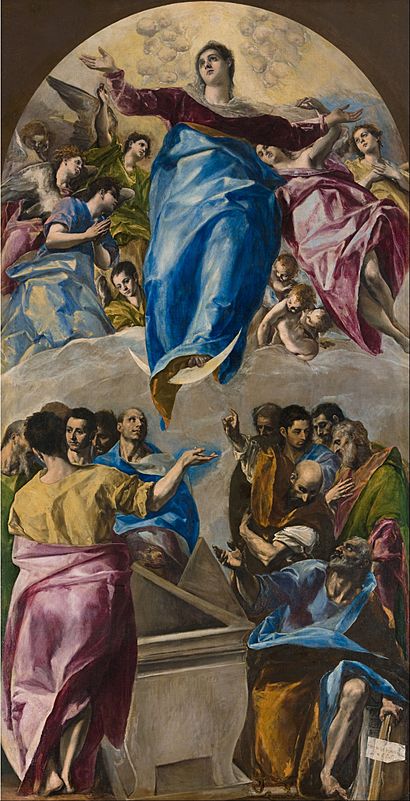Assumption of the Virgin (El Greco) facts for kids
Quick facts for kids Assumption of the Virgin |
|
|---|---|
 |
|
| Artist | El Greco |
| Year | 1577-1579 |
| Medium | Oil on canvas |
| Dimensions | 403.2 cm × 211.8 cm (158.7 in × 83.4 in) |
| Location | Art Institute of Chicago, Chicago |
The Assumption of the Virgin is a famous painting by the Greek artist El Greco. He painted it between 1577 and 1579. This artwork was a very important part of the main altar in the church of Santo Domingo el Antiguo in Toledo, Spain.
It was the first of nine paintings El Greco was asked to create for this church. The painting marked the start of his 37-year career in Toledo. El Greco was influenced by Michelangelo, another great artist. Because of this, his painting looks very Italian. It shows figures that look real and strong. The colors are also similar to those used in Rome.
El Greco's painting of the Assumption of the Virgin looks a bit like Titian's painting on the same topic. In both, the Virgin Mary and angels are shown above. The apostles are below. In El Greco's work, the Virgin Mary floats upwards. This shows her purity. The apostles stand around her empty tomb. They look surprised and worried.
What is the Assumption of Mary?
The story of the Virgin Mary's Assumption is not in the New Testament of the Bible. However, it appears in older religious writings from the 3rd and 4th centuries. By the year 1000, many people in the Western Church believed this story. It became a formal Catholic belief in 1950.
This event became a popular subject in Western Christian art in the 12th century. It was often shown with other stories from the Life of the Virgin. The Cistercian Order and Saint Bernard of Clairvaux especially encouraged these "Marian" subjects.
Later stories added more details, like the presence of the Apostles. Artists then followed these new details. By the end of the Middle Ages, large altarpieces gave artists a chance to show off their skills. They could create complex scenes with many figures and beautiful colors. After the Reformation, this topic helped show the Catholic Church's beliefs.
Where the Painting Has Been
The painting was ordered for the Santo Domingo el Antiguo church in Toledo. Don Diego de Castilla asked El Greco to paint it in 1577. The painting stayed in this church for more than 200 years.
Around 1830, the painting was sold. It went to Infante Don Sebastián Gabriel de Borbón y Braganza in Madrid. In 1835, the Spanish government took the painting from him. It was placed in the Museo Nacional de Trinidad in Madrid. But in 1861, the painting was given back to Don Sebastián.
After Don Sebastián died in 1875, his family started selling his art. His widow, Infanta María Cristina de Borbón, owned it until she died in 1902. Then, her family lent the painting to the Museo del Prado in Madrid from 1902 to 1904.
In 1904, the American painter Mary Cassatt helped sell the painting. She convinced a famous art dealer, Paul Durand–Ruel, to buy it. H. O. Havemeyer provided the money. Finally, in 1906, the painting was sold to the Art Institute of Chicago. This is where it is today.
See Also
 In Spanish: La Asunción de María (Santo Domingo el Antiguo) para niños
In Spanish: La Asunción de María (Santo Domingo el Antiguo) para niños
- Assumption of the Virgin Mary in art
- Marian art in the Catholic Church

